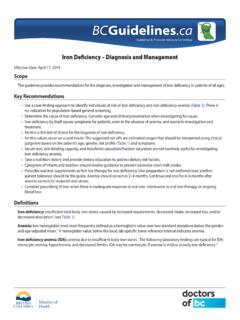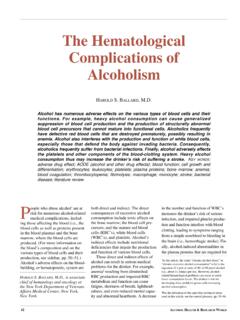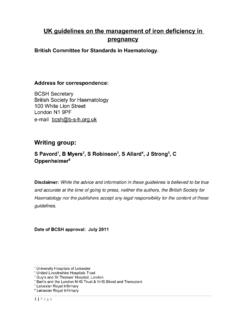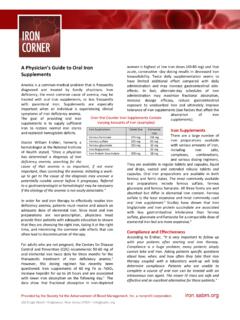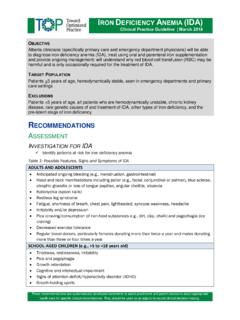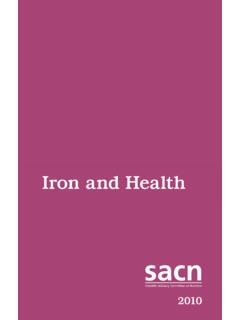Transcription of Chapter 4. Nutritional Assessment and Interventions
1 Chapter 4. Nutritional Assessment and Interventions Prepared by James Sargent, MD Chapter 4. Nutritional Assessment and Interventions Table Summary of Recommendations for Nutritional Assessment and Interventions Nutritional measures have not yet been proven to have a clinically important impact on elevated blood lead levels (EBLLs) in children. However, children with EBLLs are often at risk for poor nutrition, and their caregivers should receive Nutritional counseling to help these children obtain a well-balanced and age-appropriate diet. Assessment Test children at risk for anemia ( , those from low income, migrant, or recently arrived refugee families, or those qualifying for the Special Supplemental Nutrition Program for Women, Infants, and Children [WIC]). -Between ages 9 and 12 months -6 months later -Annually from ages 2 to 5 years Evaluate the diet of children at risk for anemia, paying particular attention to dietary iron , vitamin C, and calcium. Interventions Evaluate the WIC eligibility of children with EBLLs and ensure their access to this program if eligible.
2 Advise caregivers to provide children with an adequate intake of iron -containing foods. Recommend that they: -Introduce pureed meats as soon as the child is developmentally ready. -Provide one serving of lean red meat per day to older children. - Provide supplements only under the supervision of a physician or nutritionist and only when anemia or iron deficiency is documented. Encourage caregivers to provide children with adequate intake of vitamin C-containing foods. Recommend that they: -Provide two servings of fruit juices or fruits per day. -Provide supplements only under the supervision of a physician or nutritionist. Encourage caregivers to provide children with adequate intake of calcium (500 mg/day @ 1-3 years; 800 mg/day @ 4-8 years). Recommend that they: -Provide two servings per day of dairy products or other calcium-rich foods. - Provide supplements only under the supervision of a physician or nutritionist. Always keep recommended Interventions within the ability of the caregiver toimplement them.
3 Managing Elevated Blood Lead Levels Among Young Children 61 Chapter 4. Nutritional Assessment and Interventions Introduction While the Assessment and remediation of lead sources should be the top priority for the management of children with EBLLs, Nutritional Interventions may also be beneficial (1-4). This Chapter evaluates the evidence supporting commonly used Nutritional Interventions , makes recommendations, and suggests an agenda for future clinical research. In evaluation studies on the effects of various Nutritional Interventions on EBLLs, we considered both the design of the studies and the effectiveness of the Interventions . Because of a lack of randomized, controlled clinical trials of Nutritional Interventions among children with EBLLs, most recommendations are based on generally accepted Nutritional principles, as well as on the results of adult human, animal, or cross-sectional studies, with greater weight being given to those studies with designs that are less subject to bias and inferential error.
4 Nutritional Interventions : Summary of the Evidence iron Are children at higher risk for EBLLs also at higher risk for iron deficiency ? Despite declines in the prevalence of iron deficiency over the past 30 years with the routine supplementation of infant foods with iron , iron deficiency remains the most common Nutritional deficiency in infants and young children (5). Data from the Third National Health and Nutrition Examination Survey (NHANES III) indicate that in 1988-94, 9% of toddlers aged 1 to 2 years were iron deficient (6). As with EBLLs, young age, poor nutrition, and low socioeconomic status are associated with iron deficiency . In addition, some reports suggest that iron deficiency in young children is associated with pica, a risk factor for lead ingestion (7-10). In short, many Nutritional and behavioral factors associated with iron deficiency may also be found in children with EBLLs. Is iron deficiency associated with EBLLs? Because animal studies and other evidence suggest that iron deficiency and EBLLs are associated, the Centers for Disease Control and Prevention (CDC) in the past has recommended providing an iron -rich diet for all children with EBLLs, evaluating children with blood lead levels (BLLs) > 20 Fg/dL for iron deficiency , and treating iron deficiency if present (11).
5 However, the association between EBLLs and iron deficiency in children is not well defined. It is unknown whether this relationship is causal and operating through a Nutritional or physiological mechanism or whether it is merely the result of shared risk factors. Prospective studies of children with and without iron deficiency living in lead-contaminated environments are difficult to conduct since treatment is indicated for both iron deficiency and EBLLs. Therefore, most studies that address this question are case series, case-control studies, or cross-sectional surveys. Though the results of most early studies suggested that iron deficiency is more common among Managing Elevated Blood Lead Levels Among Young Children 62 Chapter 4. Nutritional Assessment and Interventions children with EBLLs, these studies can be criticized for one or more of the following reasons: 1) they lacked an appropriate comparison group; 2) they screened for EBLLs with erythrocyte protoporphyrin, an indicator of both lead and iron status; or 3) they failed to adjust results for factors associated with both EBLLs and iron deficiency , including age and socioeconomic status.
6 Of the four studies we found that avoided these methodological problems, two reported a positive association between iron deficiency and BLLs in children and two suggested no association. Each study used different definitions of iron status and EBLL. Of the studies finding a positive association, one suggested iron deficiency in children was associated with a 60% increased risk for a BLL > 10 Fg/dL after adjustments for children s age, hemoglobin level, and insurance status (12). The second, a study on dietary iron , found that children in the highest quartile for iron intake were at a significantly lower risk of having a BLL > 15 Fg/dL, after adjustments for maternal education, children s lead exposure, age, and total caloric intake (odds ratio , 95% confidence interval, ) (13). Of the studies that indicated no association, one was conducted among black children 11 to 33 months of age who resided in urban areas, and the results may not be applicable to other groups (14).
7 In that study, the prevalence of iron deficiency was 7% among children with BLLs 20 to 44 Fg/dL and 5% among children with BLLs < 10 Fg/dL. The other study, using NHANES III data and published only in abstract form, reported no association between iron deficiency (with or without anemia) and BLLs > 10 Fg/dL after adjusting for age of housing; education of household head; and children s age, race, and poverty status, and intake of fat, calcium, and vitamin C (15). During the 1980s, some prospective studies of children s BLLs and development gathered data on the children s iron status as well; most of the data from these studies are unpublished. Bornshein (personal communication, University of Cincinnati Medical Center, November 1988) found that Cincinnati children who became more iron deficient (as evidenced by increased total iron -binding capacity) had greater increases in BLLs, but McMichael et al. (16) and Bellinger (personal communication, Harvard Medical School, March 1989) found no association between BLLs or changes in BLLs and initially low serum ferritin levels.
8 Neither study, however, adjusted for children s use of iron supplements or for other factors. If children with initially low serum ferritin levels received iron supplements, this could have affected the association between initial low serum ferritin levels and changes in BLLs. Does iron deficiency increase absorption of lead? Some animal studies suggest mechanisms by which iron levels could affect lead retention. For example, one study of rats indicates that iron and lead absorption may be mediated by common carriers and that ingested iron decreases the absorption of lead in a dose-related manner, presumably by competitive inhibition of the carrier protein (17). Moreover, iron -deficient animals have significantly higher rates of lead absorption than iron -replete ones (18). However, the effect of iron levels and iron supplementation on radiolabeled lead retention in humans is controversial, with at least one study finding an effect (19) and at least one not (20). In their latest Managing Elevated Blood Lead Levels Among Young Children 63 Chapter 4.
9 Nutritional Assessment and Interventions study, Watson and colleagues (19) found a correlation between lead and iron absorption; however, the mean lead-absorption value for iron -deficient subjects was not significantly different from the value for those who were not iron deficient. No data are available for children. Does iron deficiency enhance the adverse effect of lead on development? Although iron deficiency may not modify children s risk for lead exposure or retention, iron deficiency and EBLLs have similar toxicity profiles. Both result in a lower production in heme; this is manifested clinically by higher erythrocyte protoporphyrin levels in children with EBLLs and iron deficiency than in those children with either condition alone (21). More importantly, both iron deficiency and EBLLs have a deleterious effect on cognitive development. This raises the possibility that the neurodevelopmental effects of lead may be more severe when iron deficiency is also present.
10 However, there is no evidence to suggest that iron deficiency modifies the neurodevelopmental effect of EBLLs. Instead, in one study comparing the cognitive development of children living near a lead smelter with that of those in a nearby town in Yugoslavia, researchers found the neurodevelopmental effects of iron deficiency and EBLLs to be independent of one another (22). Does iron supplementation have an effect on BLLs? There is evidence to suggest that iron -sufficient children excrete more urinary lead when chelated with EDTA, although the increase is small and probably not clinically significant. In addition, after iron administration, chelation-induced lead excretion increased among patients with iron deficiency . The study in which this occurred, however, did not address the effect of iron deficiency on BLLs and lead excretion in the absence of chelation (23). In a study conducted by Ruff and colleagues (24), children with EBLLs and iron deficiency were given iron supplements, whereas children with EBLLs but no iron deficiency were not.











